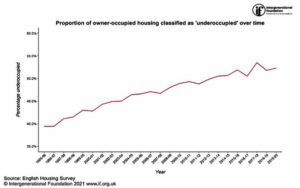There has been much talk in the media of a further watering down of the Government’s planning reforms. Opposition appears to be driven from Tory backbenches. This would be a huge mistake. Whilst no reforms are perfect there is a pressing need to make changes to enable more new homes to be delivered.
Home County Tories are apparently worried about potential green belt infringement. A more general perception also purportedly exists that new housing in their constituencies will water down Tory votes. This is short sighted but also would be a fatal miscalculation threatening to further limit and disenfranchise an entire generation. They will not thank them for such a betrayal.
Generation Rent and Housing Outcomes
The Institute of Fiscal Studies has produced a useful chart to highlight the reduction in the proportion of homeownership levels amongst 25-34 year olds over the course of the 21st century.

The chart shows there has been a sustained decline in levels in homeownership amongst the young. This is despite highly interventionist policies such as Help to Buy being introduced with the specific task of boosting first time buyer levels.
Help to Buy might be said to have ‘steadied the ship’ but is set to end (rightly) in 2023. You only have to look at the affordability calculations in many of our cities to know that its end will lead to a further fall, and probably a sharp one.
There is of course a counter argument. It is that many young people are no longer obsessed with homeownership and instead are getting on with enjoying their lives. This might be true for some. However, all the data suggests the majority of young people would still like a shot at owning something and they are not getting it.
Another interesting graph, this time courtesy of the Intergenerational Foundation using data from the English Housing Survey illustrates the rising level of under occupation for the haves – those that have homes.

Under-occupation of owner-occupied housing has gradually increased. Conversely, at the same time those in rented accommodation has experienced a rise in overcrowding. This is the impact of the conversion economy, if we do not build new homes, landlords naturally seek to carve up existing space in order to monetise.
Research by the LSE identified that young Londoners living in shared accommodation during lockdown had on average just 9.3sqm of private personal space (equivalent to a small garage), with 37 per cent sleeping AND working in their bedroom. What a contrast with the graph above!
Moreover, nearly half of respondents (46 per cent) reported not having a suitable place to work and many were affected by noise (44 per cent) and a lack of privacy (43 per cent) as they tried to juggled work and life in the same crowded space. Have a look, it’s worth a read.
In conclusion, there is nothing fair about this housing market. It is distorting life outcomes for many and in the long term we need a planning system which is capable of delivering many more new homes of all tenures. This system is not just about giving consents, it’s about giving consent efficiently and viably so that the development industry and local authorities are not knackered out by the experience.
Part of the problem with the current system is that it creates conflicts of herculean proportions. That’s why I am broadly in favour of much of the Government’s reforms which I will write more about in my next post.










